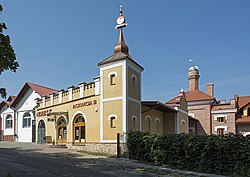Tarnobrzeg
For centuries Tarnobrzeg remained a small town, which did not develop until the post-World War II period, when it became center of an industrial area, based on rich sulfur deposits.
Finally, Tarnobrzeg prevailed, and other towns, founded by the Tarnowski family, were also named in a similar fashion, such as Tarnogród and Tarnopol.
Nevertheless, patron saint of the region, is still called Our Lady of Dzików (see also Dominican Church and Convent of Assumption of Mary in Tarnobrzeg).
Rail lines stem from Tarnobrzeg into four directions: southwards towards Dębica, southeast towards Rzeszów, east towards Stalowa Wola, and northwards, towards Sandomierz.
As a result, in the late 1970s, the size of the town quickly grew, when several villages and settlements (Machow, Dzików, Miechocin, Wielowieś, Sielec, Podleze, Sobow, Mokrzyszow) became part of Tarnobrzeg as its districts.
Boroughs, districts and osiedla of Tarnobrzeg include: Wielowieś, Sielec, Chwałki, Borów, Wymysłów, Zakrzów, Zwierzyniec, Dzików, Podłęże, Serbinów, Nadole, Old Town, Wielopole, Biała Góra, Podchoiny, Chomki, Siarkowiec, Skalna Góra, Przywiśle, Mokrzyszów, Piastów, Sobów, Chałupki, Miechocin, Ocice, Kozielec, Kajmów, Machów, Nagnajów.
Tarnobrzeg, located very close to the Russian-Austrian border, sustained heavy damage during World War I by invading armies.
Stanislaw Tarnowski (1541–1609), who was a courtier of Kings Stefan Batory and Sigismund III, managed to convince the latter to grant town charter to Nowy Tarnów, later called Tarnobrzeg.
Tarnobrzeg is situated in a region of Poland that is relatively distant from the better-known, larger Jewish communities of the country which were located in cities such as Warsaw, Kraków, Lublin, Lwów, and Wilno.
In the years 1772–1918 (see: Partitions of Poland), Tarnobrzeg was in the province of Galicia as part of the Austro-Hungarian Empire, based in Vienna.
Due to progressive initiatives following Napoleonic times, Tarnobrzeg citizens including the Jewish community benefited from free compulsory public education mandated by the Austrian Emperor.
There were several affinity groups among the thriving Jewish population before World War II, including Hasidic, Zionist, Bundist, and others.
Hauser was a wealthy businessman, trader, and landholder dating from Napoleonic times through the reign of Austrian Emperor Franz Josef.
Following the signing of the German-Soviet Frontier Treaty Jews were being expelled to the Soviet zone of occupation across the San river beginning 2 October 1939, with many others, deported to Mielec and Sandomierz.
Many of them died due to the extremely rugged conditions, for which they were unprepared, and the poor supplies available in wartime trans-Ural Russian Asia.
The Jeziórko mine stayed open as long as it did because of the introduction of the modern Frasch process of sulphur extraction.





